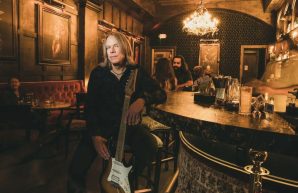Interview : Robert Cavuoto
Early this year Gary Hoey released his latest blues creation, Neon Highway Blues via Mascot Label Group/ Provogue Records. The self-produced album features 11 soulful blues tracks by Gary with appearances by Eric Gales, Lance Lopez, Josh Smith and Gary’s son, Ian.
Many of the blues songs on Neon Highway Blues are infused with his rock sensibility. It turns the blues up a notch and provides an extra kick like on “I Felt Alive” and the slow-tempo instrumental “Waiting on the Sun.” As you would expect with any genera of music that Gary takes on, his abilities as a highly talented guitarist shine through. On Neon Highway Blues Gary does a masterful job of playing and singing the blues.
I caught up with Gary while on tour to discuss his passion for the blues, the making of Neon Highway Blues, and inspiration in finding his unique guitar tone!

Robert Cavuoto: What was the inspiration for putting out this soulful, blues-oriented CD?
Gary Hoey: We have been on the blues path for the last few CDs with Deja Blues and Dust & Bone plus being with Mascot/ Provogue Records, we wanted to do the blues-rock thing for a couple of CD’s. So Neon Highway Blues is a continuation of that theme while incorporating a little more of the rock side into the blues.
Robert Cavuoto: You did a tremendous job on the CD, two of my favorite songs were “I Felt Alive” and “Waiting for the Sun,” what can you tell me about their creation?
Gary Hoey: My history is based on instrumental music when I wrote “Waiting for the Sun” I thought it was a pretty melody like a Jeff Beck song. We played it live the other night, and it was gigantic! It’s a very slow tempo and takes a lot of restraint to do so. It almost brought me to tears. “I Felt Alive” goes back to my Black Sabbath and Led Zeppelin influences with that slow groove rock. Live we extend it and have a good jam on it. It came out of nowhere, and we just kept working on the riff. It really turned out to be one of my favorites.

Robert Cavuoto: You’re such an innovative guitar player, do you feel you always have to keep re-inventing yourself CD after CD or after a period of time to keep you, and you’re fans excited?
Gary Hoey: I think so. In my career I have done Christmas music, Heavy Metal instrumental, and surf music; there are a couple of reasons why. Creatively I either needed to change, grow, or be excited to do something different like scoring a surf movie. I love a challenge so when I take on something I get into it deep; I’m a bit of a scientist and love to study different styles and genres of music. The other part of it is in order to survive in this business you have to re-invent yourself and try something different to keep people interested in what you are doing.
Robert Cavuoto: Most established bands can’t manage to put out as many CDs as you have in their career; how do you do it?
Gary Hoey: I’m a bit of workaholic. I’m always recording and setting goals for myself. I think it has just happened. I don’t want to talk like I’m that prolific, but I’m really able to keep the projects coming and keep the kids fed [laughing].
Robert Cavuoto: What are a few things about your approach to the guitar that you feel are your own and defines what you do?
Gary Hoey: Every guitar player probably doesn’t think they have their own style because we all take from other people and draw from influences. Sometimes it’s hard to pinpoint. For me, what sets me apart and keeps me true to myself as a player is try to find my styles and tones organically rather than doing a lot of tricks in the studio. Perhaps the way I use my delays and reverbs; like every guitar player has their own thing. My two main Fender Strats have dual Humbuckers which gives me the power in the sound. Combining the Humbuckers with the Strat, I think gives me my unique sound.

Robert Cavuoto: What did you use to track this new CD?
Gary Hoey: I used the Resonator in a few places like on “Your Kind of Love” and “Damned if I Do.” I used my blue reverse headstock Fender on “I Felt Alive” to get that big sound; it’s my main guitar on any drop tuning songs. I used the Strat with the flag on it for more down-home blues songs. I also used my 50th Anniversary Fender Strat, which I love, on “Mercy of Love” when I went toe-to-toe with Josh Smith who killed it on that song.
Robert Cavuoto: How important is tone to you compared to the other aspects of playing?
Gary Hoey: Tone is everything to me as it inspires the playing. Any guitar player will tell if you give them an amp with terrible tone, they might not play good [laughing]. What kept slowing down this CD was my experimenting with different gear. I kept going around in circles. I would bring out the 1978 Super Reverb the Vox. I would mic-up the Bassman amp then go back to my EVH 5150 III head with 4 x 12 cabinet and Celestion 30’s. I would mic-up my live rig which is where my sound is the best. I had to remind myself to dumb it down and make it work. Certain heads might have worked for BB King or Albert Collins in 1964, but it doesn’t work for Gary Hoey now! I own 40 guitars but only play two of them on the road for the last 27 years. Those are the two that feel good in my hands. That is what I discover about my tone. People would come up to me after a show and tell me they love my tone. That is the best compliment I can get. My advice to other guitarists is to find something that works for them; you don’t have to change all the time. Once Stevie Ray Vaughan found his tone that was it!
Robert Cavuoto: What was it like to work with your son, Ian on this CD?
Gary Hoey: It was awesome just having him play and record with me on the CD. It was a dream come true. He is 17 years old now, and at the time of recording, he was 16. I started teaching him a guitar when he was five. Over the years I had brought him on stage to jam with me. A few years back he discovered the blues and plays it with passion. Maybe because I was playing the blues, it influenced him. He played on “Don’t Come Crying,” and when he came into the studio, I tricked him. I said lets jam on this tune and didn’t tell him we were recording. He started playing this great stuff and then told him I was putting him on my new CD [laughing]. Now he wants a career in the music business; he wants my gig!
Robert Cavuoto: What are your thoughts about that; it’s a tough business to crack.

Gary Hoey: It’s funny that you say that as I just had the same conversation with my wife the other day. Ian is graduating high school next year, he’s a Quarterback on the football team, he is wicked smart with straight A’s, and going to college. He says to me he wants to be a musician. He loves all kinds of music. I’m actually scared for him to go into the music business. It’s hard to call it a business sometimes. One minute you’re making it the next you’re not. I have been blessed. My gut tells me he won’t have to work as hard as I did because he has me to help and guide him. I’m not going to stop him from doing what he really loves. I’ll encourage and support it.
Robert Cavuoto: Tell me about the significance of the CD title – Neon Highway Blues?
Gary Hoey: I always like to have the CD completed before I decide what it’s going to be called. I look at the songs to see if there is one that best depicts the feel of the CD or just a cool title. I’m a bit of marketing guy, so I try to look for something catchy and easy off the tongue. One of the last songs I wrote was “Neon Highway Blues.” It was a cool trippy Dobro thing, and it reminds me of a David Lynch movie whenever I hear it. It has an eerie sound like I was playing the Dobro while drinking [laughing], but I wasn’t. I really like the title because it reminds me of when we are on the road looking for the neon lights for coffee, dinner, or where the gig is. It makes me feel like being on the road and the essence of the blues. The fact that the title end with the word “blues” will let people know it’s a blues CD [laughing].









